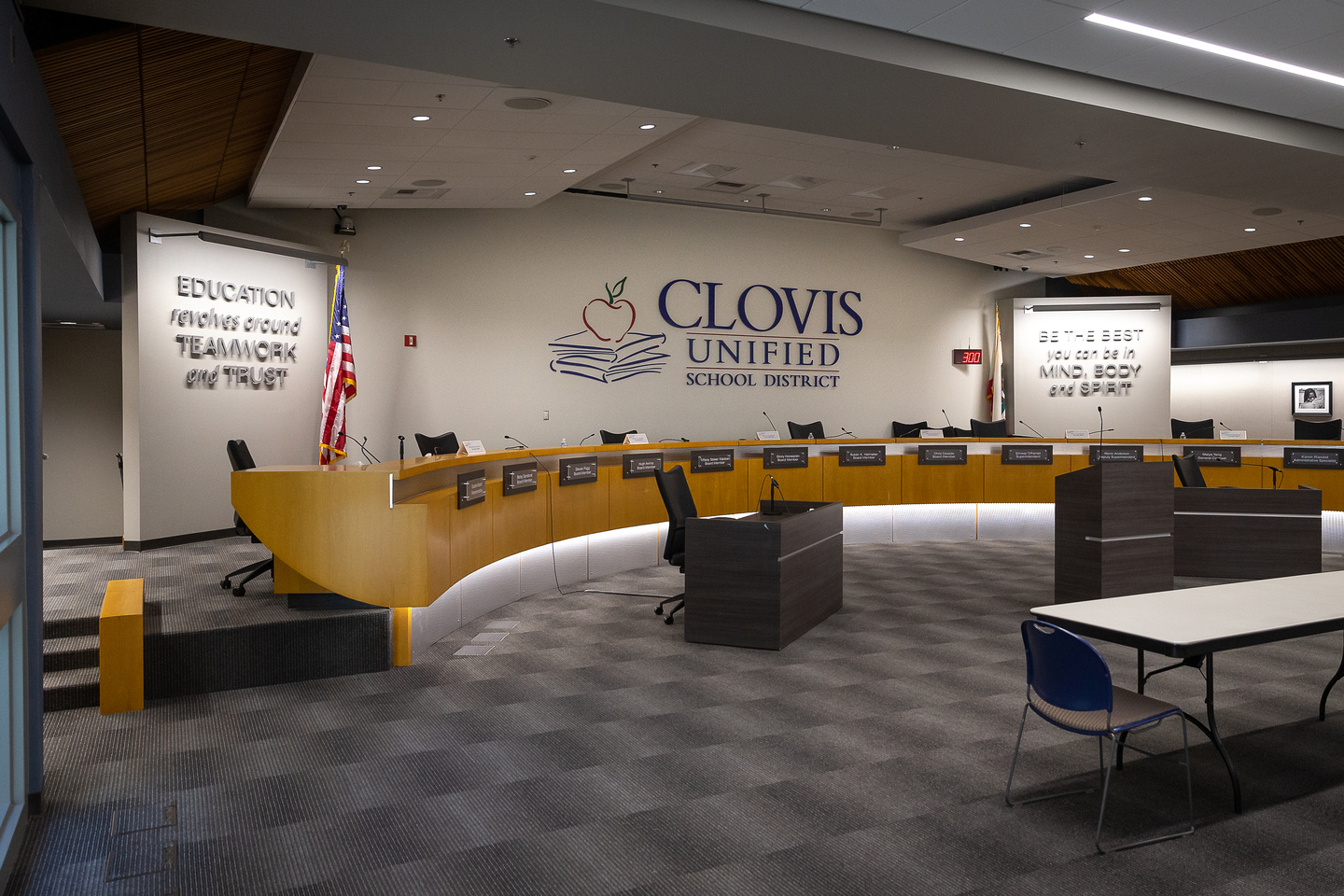The Fresno City Council is looking at some tough budget decisions later this month.
The council’s dilemma is an old one: Lots of needs, not enough money.
Two meetings in Downtown Fresno on Wednesday tell the tale. The first was a news conference at Police Headquarters, where Chief Jerry Dyer discussed monthly crime statistics. The second was a meeting of the Housing and Community Development Commission at City Hall, where the allocation of federal grants took center stage.
Let’s begin with the Chief.
“I do want to start out with some of the good news,” Dyer told reporters. “There are some significant reductions in a number of areas. In fact, overall violent crime is down in this city 8.3%, which is significant.”
Dyer was talking about Jan. 1 through July 12, 2017 compared to the same period in 2016.
Rape was down 13.4%. Robbery and aggravated assault were down nearly 10% each.
Property crime in the first half of 2017 was down slightly compared to 2016. The big drop is in auto theft – down 15.1%.
But two categories of violent crime have the Chief worried.
The first is murder. Fresno had 38 homicides through July 12. In all of 2016, there were 39 homicides.
Thirty-two of the 38 homicides in 2017 were in the Southwest, Southeast and Central policing districts.
Gunfire is turning parts of Fresno into a war zone. There were 42 shootings in the previous 28 days, at least half gang-related. A dozen or more rounds were fired in many of the shootings. In the five days between June 29 and July 3, Fresno had 10 shootings.
Twenty-four homicides involved gangs.
“What’s driving murders in our city is really four categories,” Dyer said. “People that are involved in gangs; domestic murders – husband vs. wife; individuals that are facing mental health challenges; and the homeless. Some of these intertwine.”
The Police Department is responding with new initiatives to fight gangs, Dyer said. Police also are teaming with Fresno County health officials to help people with mental health issues.
The second category of violent crime that has the Chief especially worried is domestic violence.
There have been 319 domestic violence incidents through July 12, compared to 252 for the same period in 2016. That’s a spike of 26.9%.
Domestic violence and murder also are intertwined.
“Of the category of aggravated assault, within that is domestic violence,” Dyer said. “Domestic violence is one of those areas that we have seen trending upward all year long. What that tells us is that there is not only an increase in the number of domestic violence incidents, but there is also an increase in the severity of injury to the domestic violence victim that causes them to fall into this aggravated assault category. Not every domestic violence incident is considered an aggravated assault, but when the injury rises to a certain level it becomes an aggravated assault.”
Dyer reviewed an all-too-common pattern in domestic violence incidents.
“At any given time we know that there are at least 100 suspects wanted for the crime of domestic violence,” Dyer said. “That means that a domestic violence incident occurs. The officers respond. Before the officers arrive, the suspect, generally a male, leaves the area. We take a report. We put that individual on the daily crime bulletin – they’re wanted for domestic violence.
“Generally, within a seven-day period, there’s a high likelihood that that individual is going to return to that location to further victimize his wife. And we also know that as a result of that person – the victim – reporting that crime, often times that injury becomes much more severe and rises to the category of aggravated assault. We know in two of the cases this year a husband murdered his wife.
“On a daily basis in each of the policing districts we are going to be putting together what’s called Domestic Violence Apprehension Teams. We will be identifying those individuals that are wanted. On a daily basis, seven days a week, we will be going after these individuals that are wanted for domestic violence so that we can get them off of the streets in those first 48 to 72 hours.”
These monthly “Crime View” news conferences deal mostly with numbers and field operations: This crime category is going up, this crime category is going down, here’s what officers are doing to catch the bad guys.
But Dyer also likes to invite one or two of his district commanders to the microphone for brief reviews of specific crime-fighting efforts.
Captain Mark Salazar, commander of the Southwest district, was one of those speakers on Wednesday.
Four of Fresno’s five policing districts saw an increase in shootings in the previous 28 days. Only Southwest saw a drop – 24.5%.
“What drives crime in Southwest Fresno is gangs,” Salazar said. “We are focused on the most chronic gang members in Southwest Fresno. We’ll have operations on a daily and weekly basis. We’ve done that from the start this year.”
Salazar said Southwest has seen a 40% drop in the number of people shot. One of the keys, he said, is strong and innovative patrolling.
“We’re going to continue to focus on those things because with gangs if we have a shooting in Southwest Fresno it’s going to trigger a shooting in Central Fresno, Southeast Fresno and Northwest Fresno. We’ve got to get right in the middle of it. And we’re pretty quick in getting in the middle of it and stopping it before it expands.”
Salazar then came to what I thought was his most important point.
“And there are some of the things we’re doing are with our youth,” Salazar said. “We’re engaging them like never before. We have partnerships with Fresno Unified mentoring programs. We’re in every elementary school, mentoring them. I was there at Columbia (Elementary School) yesterday with Lt. Ramsey, and we have a group of kids at Columbia. We’re getting them during lunchtime during the Fresno Unified mentoring program and we’re getting them after school and we’re providing outings for them like they’ve never seen before – Monterey Bay Aquarium, Storyland, the zoo, Fresno State basketball games. These are kids that never leave the Westside. We’re doing those things, as well.
“For Fresno PAL (Police Activities League), we have a logo. We have an officer in the middle, holding the hand of a little girl and (with) an arm around a little boy. That’s what we’re going in Southwest Fresno with these kids because they’re right in the middle. You can tell them and they’ll tell you: ‘I can go straight, or I’m going to follow my brother or my uncle’ (into gangs). And they live in neighborhoods that have a lot of gang crime. So, we’re right in the middle. Our community partnerships with everyone in Southwest Fresno are strong. That’s what’s helping us in Southwest Fresno with the crime reduction – on top of the enforcement, there’s the prevention and the intervention.”
With these thoughts – more murders, more domestic violence, fractured neighborhoods, the power of prevention and intervention – rattling in my head, I headed late Wednesday afternoon to the Housing and Community Development Commission meeting.
The commission is an advisory body. It had just one action item on the agenda: Figure out how to spend $11.6 million from four pots of federal money designed to make Fresno a better place to live in.
The two pots we’re concerned with here are Community Development Block Grants and Emergency Solutions Grants – CDBG and ESG, for short.
The City Council and the Mayor love to spend CDBG money. The dough is to go only into lower-income neighborhoods. The spending rules are generous (although, on occasion, City Hall has managed to stretch them to the point of getting the feds upset).
ESG money mostly goes to helping the homeless or the desperate find shelter on short notice.
Fresno in the 2017-18 fiscal year has $6.63 million from CDBG and $569,903 from ESG. The public, staff and the commission have been chewing for months on the best way to spend the money. The time has come to make firm decisions.
The commission’s charge on Wednesday: Review the staff’s spending plan, make new recommendations if necessary, then send the plan to the City Council for the ultimate decision.
The council is slated to get the commission’s recommendations on July 20.
The HCDC meeting didn’t attract much of an audience. Two interpreters sat in the back row, ready to help should they be needed. They weren’t. There were two officials from the Marjaree Mason Center, one official from Valley Caregiver Resource Center and me.
Jennifer Clark, director of the city’s Development and Resource Management Department (DARM), and Kelli Furtado, DARM assistant director, presented a superb PowerPoint report on the proposed spending plan, including the CDBG and ESG money.
To cut to the chase, Niccole Linder, Marjaree Mason Center executive director, and Michelle DiBuduo, Valley Caregiver Resource Center executive director, spoke briefly. In essence, they asked the commissioners for money.
Marjaree Mason is slated to get money in the current spending plan: $92,600 from CDBG for a facility rehab project and $140,285 from ESG (emergency shelter is the essence of Marjaree Mason’s mission). Linder asked for an increase from the ESG pot.
It wasn’t clear to me if Valley Caregivers is in the current spending plan. DiBuduo clearly thinks it should be.
Linder and DiBuduo made strong and concise cases. They said both centers do vital work to strengthen Fresno. The Marjaree Mason Center serves victims of domestic violence. Valley Caregivers serves the elderly and their families.
And in the end, Linder and DiBuduo were successful. Commissioner Barry Falke in separate motions recommended that Marjaree Mason Center receive another $100,000 and Valley Caregivers receive $141,000 to further their good work.
The commission unanimously approved Falke’s motions.
Falke then gave Linder and DiBuduo a bit of friendly advice: Be sure to show up at the July 20 City Council meeting and advocate for the grants with the same precision and passion that they displayed before the commission.
I suspect Falke was preaching to the choir. Linder and DiBuduo no doubt know they could face a fight on July 20.
Once again: Fresno has lots of needs and little money. To give $241,000 to Marjaree Mason Center and Valley Caregivers means taking $241,000 out of the hides of other providers also helping to keep Fresno’s civic life intact.
Whose hides?
Falke recommended that Marjaree Mason’s $100,000 come from WestCare California, which is getting $360,512 in ESG money. Falke said WestCare, a big corporation, could better backfill the $100,000 than a local organization with limited means.
If I heard Falke correctly, he recommended that Valley Caregivers’ $141,000 come the city Parks Department’s After School Program and the city’s Senior Hot Meals Program.
The After School Program is slated to get $632,400 from CDBG; the Senior Hot Meals Program is slated to get $127,000 from CDBG.
I didn’t catch if Falke recommended how big a hit each program should take.
At this point we should circle back to Chief Dyer and Captain Salazar. Fresno at times can be a violent place. Violent crime takes many forms. It has different types of victims and different causes. Strict enforcement of the law is one response. So, too, is prevention/intervention.
Ultimately, the Police Department is about families. Strong families mean a strong Fresno.
Then we complete the circle and return to that small conference room at City Hall and the HCDC commissioners. The Marjaree Mason Center and the Valley Caregiver Resource Center do great work helping Fresno families. So, too, do WestCare, the After School Program and the Senior Hot Meals Program.
In the middle of the circle is a pot of federal grant money. There’s never enough in it.
Of course, the City Council on July 20 could simplify matters by telling the administration of Mayor Lee Brand to find enough general fund money to fund the Marjaree Mason and Valley Caregivers requests without cutting anything from the WestCare, After School and Hot Meals grants.
But the general fund pot is always light, as well.









